Mathematical Function Type
Function |
Description |
|---|---|
abs |
Returns the absolute value of the input number. |
acos |
Returns the arc cosine of a value; the returned angle is in the range 0.0 through pi. |
add |
Adds the two inputs together and returns the result. |
asin |
Returns the arc sine of a value; the returned angle is in the range -pi/2 through pi/2. |
atan |
Returns the arc tangent of a value; the returned angle is in the range -pi/2 through pi/2. |
bitwiseAnd |
Performs a bitwise operation on the input. Returns the result. |
ceil |
Returns the smallest (closest to negative infinity) double value that is greater than or equal to the argument and is equal to a mathematical integer. |
cos |
Returns the trigonometric cosine of an angle. |
cosh |
Returns the hyperbolic cosine of a double value. The hyperbolic cosine of x is defined to be (ex + e-x)/2 where e is Euler's number. |
cubeRoot |
Returns the cube root of a number. |
divide |
Returns the result of dividing one number by another. |
exp |
Returns Euler's number e raised to the power of a double value. |
expMinusOne |
Returns (ex) - 1. Note that for values of x near 0, the exact sum of expm1(x) + 1 is much closer to the true result of ex than exp(x). |
floor |
Returns the largest (closest to positive infinity) double value that is less than or equal to the argument and is equal to a mathematical integer. |
isNull |
Returns 'value' as supplied if it is not null, otherwise returns 'nullReplacmentValue'. |
log |
Returns the natural logarithm (base e) of a double value. |
log10 |
Returns the base 10 logarithm of a double value. |
max |
Returns the largest value from two numbers. |
min |
Returns the smallest value (closest to negative infinity) from two numbers. |
multiply |
Returns the result of multiplying two numbers together. |
pow |
Returns the value of the first argument raised to the power of the second argument. |
random |
Returns a double or Integer value between the limits provided or 0.0-1.0 if no limits. The user can specify the limit range using a combination of Integers and Doubles. |
remainder |
Returns the remainder that you get when dividing one number by another a whole number of times. |
round |
Returns the double value that is closest in value to the argument and is equal to a mathematical integer. If two double values that are mathematical integers are equally close, the result is the integer value that is even. |
sin |
Returns the trigonometric sine of an angle. |
sinh |
Returns the hyperbolic sine of a double value. The hyperbolic sine of x is defined to be (ex - e-x)/2 where e is Euler's number. |
sqrt |
Returns the correctly rounded positive square root of a double value. |
subtract |
Returns the value calculated when subtracting the second argument from the first. |
tan |
Returns the trigonometric tangent of an angle. |
tanh |
Returns the hyperbolic tangent of a double value. The hyperbolic tangent of x is defined to be (ex - e-x)/(ex + e-x), in other words, sinh(x)/cosh(x). Note that the absolute value of the exact tanh is always less than 1. |
toDegrees |
Converts an angle measured in radians to an approximately equivalent angle measured in degrees. The conversion from radians to degrees is generally inexact; users should not expect cos(toRadians(90.0)) to exactly equal 0.0. |
toRadians |
Converts an angle measured in degrees to an approximately equivalent angle measured in radians. The conversion from degrees to radians is generally inexact. |

Returns the absolute value of a number. If the argument is not negative, the argument is returned unchanged. If the argument is negative, the negation of the argument is returned. Takes a Double, Integer or Long as input and returns the same type.
Special cases:
•If the argument is positive zero or negative zero, the result is positive zero.
•If the argument is infinite, the result is positive infinity.
•If the argument is NaN, the result is NaN.
Returns the arc cosine of a value; the returned angle is in the range 0.0 through pi.
Special case:
•If the argument is NaN or its absolute value is greater than 1, then the result is NaN.
Adds the two input values together, takes Doubles, Integers or Longs. Returns the result of the same type as the inputs.
(The List:Biskit option is described in the List/Set Function Type section, and the String option is described in Text Function Type)
Returns the arc sine of a value; the returned angle is in the range -pi/2 through pi/2.
Special cases:
•If the argument is NaN or its absolute value is greater than 1, then the result is .
•If the argument is zero, then the result is a zero with the same sign as the argument.
Returns the arc tangent of a value; the returned angle is in the range -pi/2 through pi/2.
Special cases:
•If the argument is NaN, then the result is NaN.
•If the argument is zero, then the result is a zero with the same sign as the argument.
•The first option performs a bitwise NOT operation on an integer. This means that every binary digit that was a 0 is changed to a 1, and every 1 is changed to a 0. Returns the result.
•The second option performs a bitwise EXCLUSIVE OR operation on two integers. Each binary digit will be set to a 1 if the corresponding bits in the arguments are different from each other. Returns the result.
Returns the smallest (closest to negative infinity) double value that is greater than or equal to the argument and is equal to a mathematical integer.
Special cases:
•If the argument value is already equal to a mathematical integer, then the result is the same as the argument.
•If the argument is NaN or an infinity or positive zero or negative zero, then the result is the same as the argument.
•If the argument value is less than zero but greater than -1.0, then the result is negative zero.
•Note that the value of ceil(x) is exactly the value of -floor(-x).
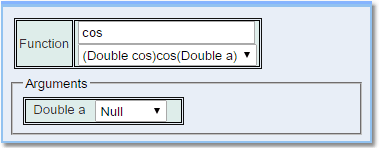
Returns the trigonometric cosine of an angle.
Special case:
•If the argument is NaN or an infinity, then the result is NaN.
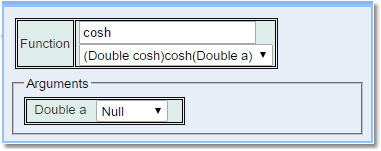
Returns the trigonometric cosine of an angle.
Special cases: If the argument is NaN or an infinity, then the result is NaN.
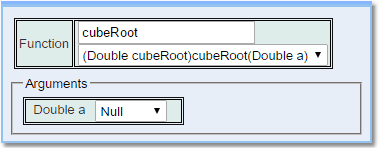
Returns the cube root of a number.
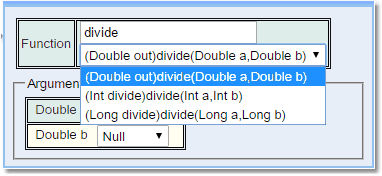
Returns the result of dividing one number by another. The inputs can be Double, Integer or Long. Returns the result of the same type as the inputs. When dividing by an Integer if the result is not an Integer it will go closer to zero. ie. 0.5 goes to 0 -0.5 goes to 0.

Returns Euler's number e raised to the power of a double value.
Special cases:
•If the argument is NaN, the result is NaN.
•If the argument is positive infinity, then the result is positive infinity.
•If the argument is negative infinity, then the result is positive zero.

Returns (ex) - 1. Note that for values of x near 0, the exact sum of expm1(x) + 1 is much closer to the true result of ex than exp(x).
Special cases:
•If the argument is NaN, the result is NaN.
•If the argument is positive infinity, then the result is positive infinity.
•If the argument is negative infinity, then the result is -1.0.
•If the argument is zero, then the result is a zero with the same sign as the argument.

Returns the largest (closest to positive infinity) double value that is less than or equal to the argument and is equal to a mathematical integer.
Special cases:
•If the argument value is already equal to a mathematical integer, then the result is the same as the argument.
•If the argument is NaN or an infinity or positive zero or negative zero, then the result is the same as the argument.
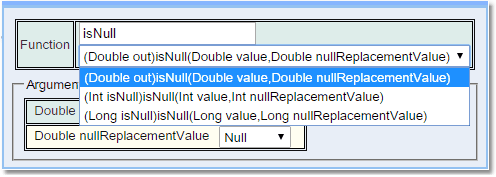
Returns 'value' as supplied if it is not null, otherwise returns 'nullReplacmentValue'. The input can be a Double, Integer or Long.

Returns the natural logarithm (base e) of a double value.
Special cases:
•If the argument is NaN or less than zero, then the result is .
•If the argument is positive infinity, then the result is positive infinity.
•If the argument is positive zero or negative zero, then the result is negative infinity.
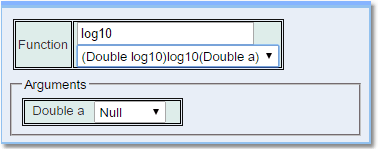
Returns the base 10 logarithm of a double value.
Special cases:
•If the argument is NaN or less than zero, then the result is NaN.
•If the argument is positive infinity, then the result is positive infinity.
•If the argument is positive zero or negative zero, then the result is negative infinity.
•If the argument is equal to 10n for integer n, then the result is n.

Returns the largest value from two numbers.The inputs can be Doubles, Integers or Longs. Returns the result of the same type as the inputs.

Returns the smallest value (closest to negative infinity) from two numbers. The inputs can be Doubles, Integers or Longs. Returns the result of the same type as the inputs.

Returns the result of multiplying two numbers together. The inputs can be Doubles, Integers or Longs. Returns the result of the same type as the inputs.

Returns the value of the first argument raised to the power of the second argument.
Special cases:
•If the second argument is positive or negative zero, then the result is 1.0.
•If the second argument is 1.0, then the result is the same as the first argument.
•If the second argument is NaN, then the result is NaN.
•If the first argument is NaN and the second argument is non zero, then the result is NaN.
•If
othe absolute value of the first argument is greater than 1 and the second argument is positive infinity, or
othe absolute value of the first argument is less than 1 and the second argument is negative infinity,
then the result is positive infinity.
•If
othe absolute value of the first argument is greater than 1 and the second argument is negative infinity, or
othe absolute value of the first argument is less than 1 and the second argument is positive infinity,
then the result is positive zero.
•If the absolute value of the first argument equals 1 and the second argument is infinite, then the result is NaN.
•If
othe first argument is positive zero and the second argument is greater than zero, or
othe first argument is positive infinity and the second argument is less than zero,
then the result is positive zero.
•If
othe first argument is positive zero and the second argument is less than zero, or
othe first argument is positive infinity and the second argument is greater than zero,
then the result is positive infinity.
•If
othe first argument is negative zero and the second argument is greater than zero but not a finite odd integer, or
othe first argument is negative infinity and the second argument is less than zero but not a finite odd integer,
then the result is positive zero.
•If
othe first argument is negative zero and the second argument is a positive finite odd integer, or
othe first argument is negative infinity and the second argument is a negative finite odd integer,
then the result is negative zero.
•If
othe first argument is negative zero and the second argument is less than zero but not a finite odd integer, or
othe first argument is negative infinity and the second argument is greater than zero but not a finite odd integer,
then the result is positive infinity.
•if
othe first argument is negative zero and the second argument is a negative finite odd integer, or
othe first argument is negative infinity and the second argument is a positive finite odd integer,
then the result is negative infinity.
•If the first argument is finite and less than zero
oif the second argument is a finite even integer, the result is equal to the result of raising the absolute value of the first argument to the power of the second argument
oif the second argument is a finite odd integer, the result is equal to the negative of the result of raising the absolute value of the first argument to the power of the second argument
oif the second argument is finite and not an integer, then the result is NaN.
oIf both arguments are integers, then the result is exactly equal to the mathematical result of raising the first argument to the power of the second argument if that result can in fact be represented exactly as a double value.
In the foregoing descriptions, a floating-point value is considered to be an integer if and only if it is finite and a fixed point of the method ceil or, equivalently, a fixed point of the method floor. A value is a fixed point of a one-argument method if and only if the result of applying the method to the value is equal to the value.

Returns a double value with a positive sign, greater than or equal to 0.0 and less than 1.0. Returned values are chosen pseudo-randomly with (approximately) uniform distribution from that range. Alternatively the range can be defined and the returned random number can be either double or integer. The integer value returned is rounded close to zero. So a double value of 1.5 is rounded to 1 and -1.5 is rounded to -1.
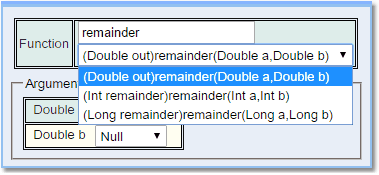
Returns the remainder that you get when dividing one number by another a whole number of times. The input can be a Doubles, Integers or Longs. Returns the result of the same type as the inputs.

Returns the double value that is closest in value to the argument and is equal to a mathematical integer. If two double values that are mathematical integers are equally close, the result is the integer value that is even.
Special cases:
•If the argument value is already equal to a mathematical integer, then the result is the same as the argument.
•If the argument is NaN or an infinity or positive zero or negative zero, then the result is the same as the argument.

Returns the trigonometric sine of an angle.
Special cases:
•If the argument is NaN or an infinity, then the result is NaN.
•If the argument is zero, then the result is a zero with the same sign as the argument.
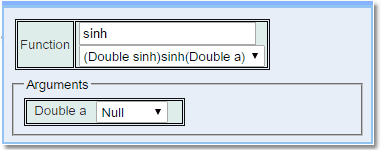
Returns the hyperbolic sine of a double value. The hyperbolic sine of x is defined to be (ex- e-x)/2 where e is Euler's number.
Special cases:
•If the argument is NaN, then the result is .
•If the argument is infinite, then the result is an infinity with the same sign as the argument.
•If the argument is zero, then the result is a zero with the same sign as the argument.
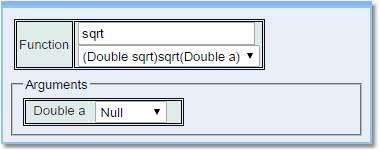
Returns the correctly rounded positive square root of a double value.
Special cases:
•If the argument is NaN or less than zero, then the result is NaN.
•If the argument is positive infinity, then the result is positive infinity.
•If the argument is positive zero or negative zero, then the result is the same as the argument.

Subtracts the second argument from the first. Takes Doubles, Integers or Longs as inputs. Returns the result of the same type as the inputs.
(The List:Biskit option is described in the List/Set Function Type section)
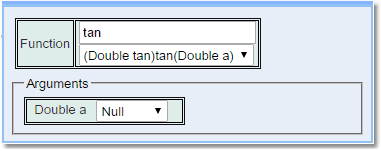
Returns the trigonometric tangent of an angle.
Special cases:
•If the argument is NaN or an infinity, then the result is NaN.
•If the argument is zero, then the result is a zero with the same sign as the argument.

Returns the hyperbolic tangent of a double value. The hyperbolic tangent of x is defined to be (ex - e-x)/(ex + e-x), in other words, sinh(x)/cosh(x). Note that the absolute value of the exact tanh is always less than 1.
Special cases:
•If the argument is NaN, then the result is NaN.
•If the argument is zero, then the result is a zero with the same sign as the argument.
•If the argument is positive infinity, then the result is +1.0.
•If the argument is negative infinity, then the result is -1.0.
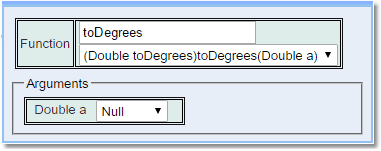
Converts an angle measured in radians to an approximately equivalent angle measured in degrees. The conversion from radians to degrees is generally inexact; users should not expect cos((90.0)) to exactly equal 0.0.
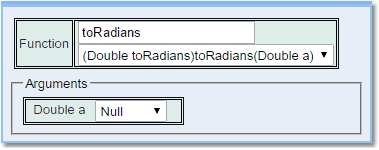
Converts an angle measured in degrees to an approximately equivalent angle measured in radians. The conversion from degrees to radians is generally inexact.






